Cet article est également disponible en: French
There’s plenty to see on the Cathar trail between Foix and Quillan – but I’ll blog about that later. This post is about the accommodation – the gîtes d’étape (bed and breakfasts), which are uniformly good, but all different. I was there walking with a group of friends from Lézignan-Corbières in May 2012.
For details of the facilities there are links to the relevant websites. Here I want write about the way walkers are welcomed. I’ll make no bones about it. The welcome is uniformly excellent. The food is excellent. We walked 116km and climbed 4384m but despite the exercise I put on 2.5kg in 6 days. That says it all!
Roquefixade – Montségur – Comus – Espezel – Quirbajou
The Relais des Pogs, Roquefixade (54€)
Run by Christian and Brigitte Chevret.
After an aperitif of rosé and grapefruit juice (popular here), we eat home-made pâté with home-made bread, lettuce from the garden, tagine, local Bethmale cheese, and home-made chocolate cake.
Half way through the meal our host pulls up a chair and sits down with us.
“Tomorrow you’ll have to survive on a sausage, a cabbage leaf and a potato. Eat up now!” We don’t need encouraging, it’s delicious. Our only regret is that we have only just started today, so we don’t have the Desperate Dan appetites to do justice to the food.
Someone asks Christian for some bottled water for the next day.
“We spent 6000 euros on the water system. The tap water is completely drinkable. But don’t drink the neighbour’s water. He spread manure above the spring. It was a disaster. Grandma spent two weeks in a coma. Typhoid. We used to be pharmacologists, my friend” He takes hold of my left arm as if he were going to take a blood sample. “The mayor asked me what he should do. Don’t interfere was my advice.”
Later, in bed, I digest my dinner with difficulty.
One thing worth knowing: sheets are provided here. Normally you have to take your own sheet sleeping bag. Not only that, but there is also a mini snooker table.
Lou Sicret, Montségur (40€)
Cold and tired after a long day, we look for Mr Massera’s house. Wandering around the streets of the village we can find nobody to help us. In the end we work out that it is called “Lou Sicret”. At the entrance we are welcomed by a lethargic sheep dog.
We have just been caught in a shower. Jean-Luc says: “Don’t take your shoes off. Get yourselves in front of the fire. He has made some herb tea to warm us up.
Yes, of course we can have some oil and vinegar to make a vinagrette for the respounchous we have collected along the way. No, there isn’t any mustard, apart from some dubious powder left by an English couple last year. A cook without mustard! He may well be friendly, but we are worried about what is going to follow.
Dinner-time: the meal starts with rosé with grapefruit juice. Then we eat our respounchous, which I find rather bitter. Pumpkin soup follows. We glug it down, taking seconds, just in case. Salad. Then the sausages and cabbage leaves are brought in. But instead of the wizened sausages of our imagination, they are monsters, easily bigger than the plate. And the cabbage is a delicious purée. The dessert is a croustade (apple pie). In short, perfect.
The cook does his stuff in a kind of hut outside, despite the existence of a fully equipped kitchen in the room where we are eating. When he comes in, an icy gust of wind blows through the door. Snow is beginning to fall on the mountain opposite us. We wonder why he doesn’t come inside but then notice a sucession of teenagers who come and grab something to eat before disappearing again. This must be the village McDonald’s.
Jean-Luc tells us that he wasn’t born here, but he has family connections which means that he isn’t treated as if he were a complete stranger.
In the morning we come down to find not only the usual wholesome bread, toast and a variety of jams, but also freshly cooked slices of bacon waiting for us. Delicious.
Village guest house at « le Barry du Haut », Comus (49€)
Nobody answers when we knock on the door but we see a notice inviting us to go in and make ourselves at home. Everything is brand new; the gîte has just reopened after renovation. There is tea, coffee and beer available, as well as a jar full of chocolates! The manager and chef, Anne Pagès arrives a few minutes later, smiling.
During the evening she tells us more about herself and the village. She wasn’t born here – in fact she comes from a neighbouring village, all of 10km away – but she has lived here for more than 50 years. She tells us that there are now only 26 inhabitants.
She feels she belongs to Comus, but, she complains: “The old folks still insist that I’m not from here.”
I suggest: “Being born here is the only part of their identity which hasn’t been eroded by the years. Everything has changed since they were young. People don’t have the same values. It’s all that is left for them to be proud of; it reinforced their sense of belonging.”
“No. The village hasn’t changed much,” she insists. “When a house is sold, you only find out afterwards. They always go to someone who has roots here already.”
Later, we come across evidence of this attachment to the village. The cemetery is not only full; there is a waiting list. The council has been obliged to turf out some of its older inhabitants whose graves were no longer being looked after. It seems that people come back to Comus for their holidays, to retire or, as a last resort, in a box.
But the village must have changed, whatever Anne says. In 1962 there were 157 inhabitants. By 2008 there were only 40, of whom 58% were 65 or over. I reckon that there are about a hundred houses now, mostly very well maintained, clearly holiday homes. There is neither a shop nor a bar.
On one of the doors of the gîte is a poster saying “All animals are useful.” Below is a photograph of a fox. Another poster portrays thousands of fluffy baby penguins. The text tells us that they all look the same but they are all different. Genetic diversity is important for the planet. Evidently Anne is influenced by the ecology movement.
All of which means that when I see a giant cartoon in the main room, I’m not sure what to make of it. The title is clear enough: “Yes to the reintroduction of the bears”. But the drawing itself is ambiguous to say the least. The bear in question is standing up. Behind it is a man, buttocks exposed, trousers around his feet. The nature of the reintroduction is obvious, though invisible.
To my mind, there are two interpretations. Either the title should be taken literally, in which case the poster supports the reintroductions. Or the cartoon is to be interpreted in conjunction with the title: only perverts could be in favour of the bears.
I say to Anne that the poster is rather ambiguous.
She replies: “I can only see one interpretation.” I don’t want to get into complications, so I leave it at that.
Yet again we eat well. Home-made sangria, a soup of radish leaves and rice, blanquette de veau (veal stew) with pasta, three cheeses including Bethmale, apricot tart. The pasta is accompanied by a kind of pesto made with ail des ours (bear’s garlic). Of course.
The Relais du Pays de Sault, Espezel (43€)
Owner: Louis Pech. See also reliboukitchen.
We have already been told several times: the Relais du Pays de Sault serves exceptional food. It’s best to work up an appetite. Rivesaltes ambré for aperitif, sausages, salad, duck confit with roast potatoes, three cheeses, strawberries and cream. No fuss. Real local traditional food.
There is a caricature of p’tit Louis (little Louis) on all the plates and his portrait on the wall so that when he springs up from behind the bar we recognise him immediately. An authentic former rugby league player. The only thing wrong is his headgear.
“I’ve just been watching the bullfight in Madrid,” he explains pointing at the black beret.
He tells us that he used to be a grocer before taking over the hotel. He is 64 – or perhaps 74, he’s not too clear about it – and has been retired for five years, at least in principle. In practice he is there every evening. Yesterday there were 160 customers.
He brings out the porrón. Actually, he brings out two of them and we all drink from them, whether we want to or not. Then he gives us a demonstration of how it should be done. He pours the wine onto his forehead and lets it run down the bridge of his nose, along its length and into his mouth. All without spilling a drop. The effect is rather bizarre: as if he had a tiny bullet hole in his forehead with the blood trickling out.
At the end of the meal he says to us: “I’m going home. I’ll leave you the key in case you want to go out. You can’t get lost. Don’t forget, the TGV station is at the top of the village and the airport at the bottom.
Next morning he is there with a plateful of pancakes and an assortment of jams to go with them. Plus dried ham, cheese, bread and toast.
The maison jaune, Quirbajou (44€)
Run by Françoise Bellis and Stéphane Warot. See also a description of life on the farm by a woofer who stayed there.
The contrast between p’tit Louis and Stéphane, our host this evening in Quirbajou, is remarkable. P’tit Louis was plump and jovial; Stéphane is gaunt and looks worried. P’tit Louis can’t wait to retire properly; Stéphane took retirement three year ago, but instead of settling down comfortably, he has thrown himself into new adventures. I admire his spirit.
“We’ve taken on too much all at once,” he tells us. “Renovating the house, starting the farm and playing host to walkers every evening. It’s too much.”
Before retiring he ran a pizzeria and a bookshop in the town of Cahors. “All my books are in boxes at present. I’m going to put shelves all along the walls when I get the time. Reading’s important.” He has even put reading lights next to each bed in the dormitory. Normally, if you want to read at night you have to use your head torch.
Stéphane, his wife and a Swiss-German woofer run an unusual establishment.
“I’m over 60,” Stéphane explains. “So I can’t get any grants. We have nine sheep and three apprentices, five goats, two pigs and two donkeys. The goats eat anything that grows high up and the sheep anything lower down. The pigs eat the kitchen waste. We have 30 hectares (74 acres) in over 200 fields. It’s mad! The fields were divided up as they passed from one generation to the next.” Everything is organic, and the renovation is more expensive than it would otherwise be because they insist on ecologically sound materials.
“Tomorrow, I’m going to start on the wood fibre insulation,” he continues.
We sit down for dinner at the same long table as the couple and their helper. The aperitif is walnut wine. Then there is a salad, organic trout with rice and braised fennel, three sorts of goat’s cheese and a chocolate mousse, also made from goat’s milk.
I’m pleasantly surprised by the goat’s cheese, which is often too dry and pongy to my taste. Stéphane’s cheese is unctuous.
“It’s because they can eat the new green grass at present. When they’ve only twigs to eat, like in the Corbières where you live, the taste is stronger.”
“We have to wean the kids at three days old so that we can have the mothers’ milk for the cheese. They are bottle-fed. They are very sweet. They follow you everywhere. I kept one even though he was the runt. In any case nobody else wanted him.”
He is active in José Bové’s Confédération paysanne. The gîte is part of the Accueil Paysan accommodation network of farmers who take in guests.
When we ask for breakfast at 7:30 in the morning. Stéphane is a bit taken aback although he agrees willingly, since we have a train to catch.
***
[The prices given above include bed, breakfast, evening meal and a picnic. Please note that there is other accommodation available in all the villages except Quirbajou. So far we have only done about half of the Cathar trail (Foix to Quillan), and even then we cheated by going directly from Espezel to Quirbajou.]


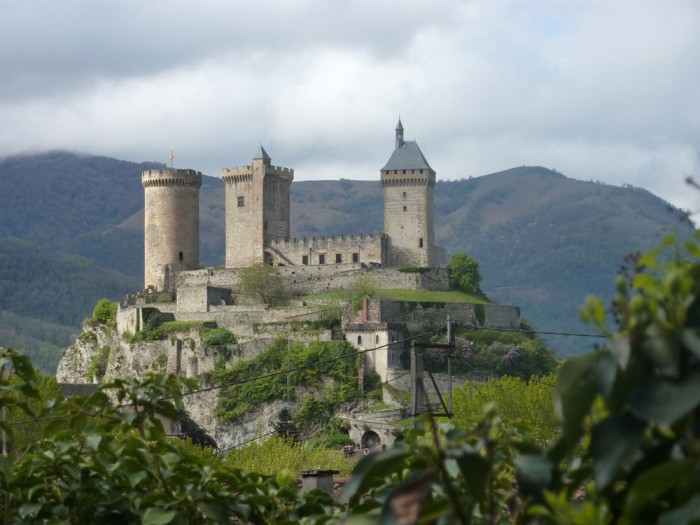
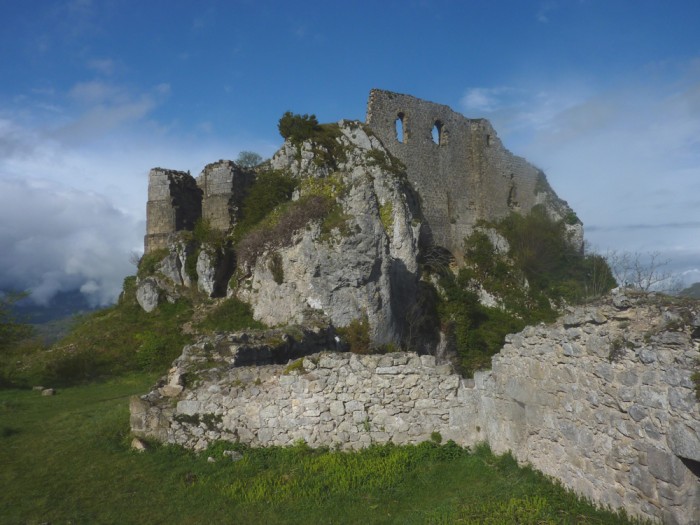
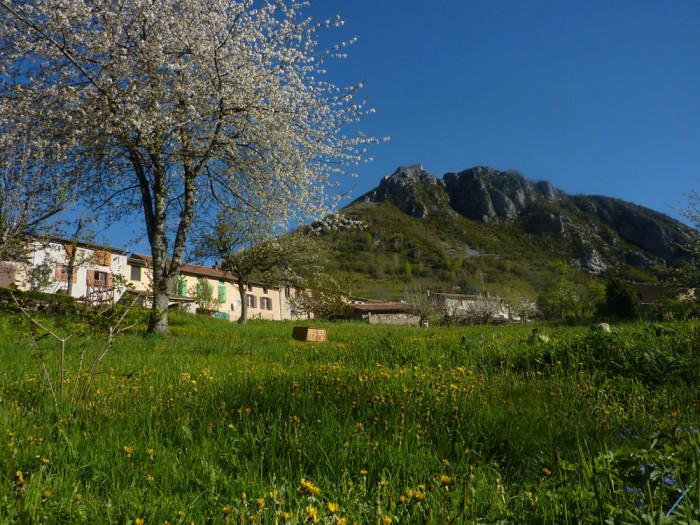


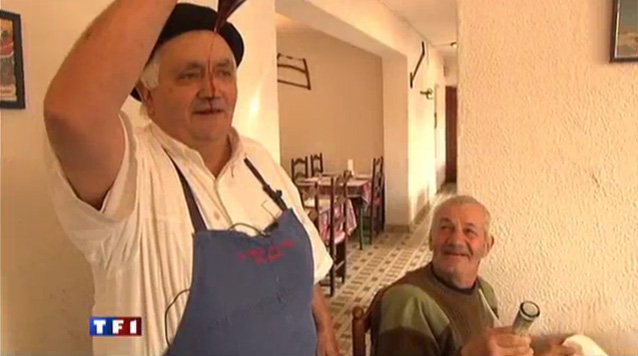
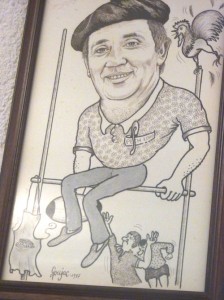

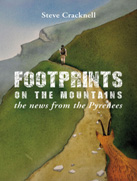
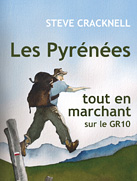
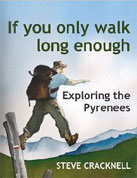

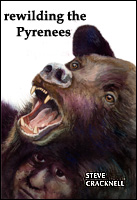



[…] When we arrive at the intermediate pastures, Jason tells us what it means to him to have bears in the Pyrenees. It is a long story and not the subject of this article… Then, given the uncertain weather, we return to the farm to the spacious airy feeding shed no longer needed for the cows. There are long tables with straw bales for seats. It is a real feast, with the wine flowing liberally. Jason demonstrates the use of the porrón, a flask with a long spout from which you drink without it touching your lips. The trick is to say ‘Carcassonne’ while drinking, taking care not to spill a drop of wine. Few people manage the challenge, to general laughter. Even though some are pretty good, no tries to imitate P’tit Louis whom I saw demonstrating his technique at the Relais du Pays de Sault. […]